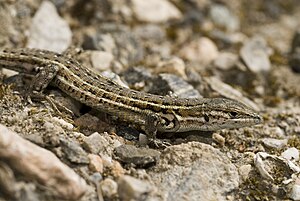Spanish sand runner
| Spanish sand runner | ||||||||||||
|---|---|---|---|---|---|---|---|---|---|---|---|---|

Spanish sand runner ( Psammodromus hispanicus ) |
||||||||||||
| Systematics | ||||||||||||
|
||||||||||||
| Scientific name | ||||||||||||
| Psammodromus hispanicus | ||||||||||||
| Fitzinger , 1826 |
The Spanish sand runner ( Psammodromus hispanicus ) is a lizard from the genus of sand walkers ( Psammodromus ).
description
With a body length of five centimeters, it is up to about 14 centimeters long and is therefore much smaller and at the same time shorter-tailed than the Algerian sand runner ( Psammodromus algirus ). In the youth it has four to six interrupted longitudinal stripes, which are composed of light spots and stretch over the copper to yellowish-brown back. Gradually this stripe drawing disappears, so that the Spanish sand runner shows a dark pattern of spots. There is often a whitish stripe on the sides. When this disappears, the lizard looks solid gray or brown.
During the mating season, the male has two blue, white-rimmed blemishes on the armpits and smaller blue spots along the sides of the abdomen. The underside has a glossy pearl gray color that varies in brownish or greenish tones.
Distribution and way of life
This lizard lives mainly in sandy terrain with low, scrubby vegetation. It runs very quickly over the sand and, if there is a disturbance, takes cover under a bush. It can often be seen on the dunes and sandy corridors of the coast, where it moves from one bush to the next at lightning speed.
Subspecies
The Spanish sand runner occurs in two subspecies in southwestern Europe.
- Psammodromus hispanicus hispanicus Fitzinger, 1826 - lives in the west and south of the Pyrenees Peninsula ,
- Psammodromus hispanicus edwarsianus (Dugès, 1829) - on the Spanish and French Mediterranean coasts , between Malaga and the Rhone .
On the basis of molecular genetic and morphological data, the Spanish sand runner was divided into three lines in 2012, two of which correspond to the two previously known subspecies P. hispanicus hispanicus and P. hispanicus edwarsianus . The third line is the new species Psammodromus occidentalis . Accordingly, the elevation of the two subspecies to separate species was proposed, but this has not yet been generally accepted.
In the first description of the author Dugès , 1829, the spelling of the species name was reproduced several times as edwarsianus (without the second d). This leads to confusion about the correct spelling to this day. About half of all publications on this subspecies or species do not use the original spelling, but speak of Psammodromus edwardsianus , as this lizard was named after the naturalist Henri Milne Edwards .
Individual evidence
- ↑ Patrick S. Fitze, Virginia Gonzalez-Jimena, Luis Mauro San-Jose, Diego San Mauro & Rafael Zardoya: A new species of sand racer, Psammodromus (Squamata: Lacertidae), from the Western Iberian Peninsula Zootaxa, 3205, p. 41 -52, 2012
- ^ Psammodromus in The Reptile Database
- ↑ Pierre-André Crochet: Nomenclatural issues in the Psammodromus hispanicus (Squamata: Lacertidae) species group. Zootaxa, 3964, 1, pp. 149-150, 2015
literature
- Heinz Schröder: amphibians and reptiles in colors. Over 80 newts, frogs, turtles, lizards, etc. Snakes of Europe. Otto Maier, Ravensburg 1973, ISBN 3-473-46116-4 .
Web links
- Psammodromus hispanicus in The Reptile Database
- Psammodromus hispanicus inthe IUCN Red List of Threatened Species 2013.1. Posted by: Juan M. Pleguezuelos, Paulo Sá-Sousa, Valentin Pérez-Mellado, Rafael Marquez, Marc Cheylan, Iñigo Martínez-Solano, 2008. Retrieved September 24, 2013.
- Photos at www.herp.it
- Photos at www.bpo-natura.de
